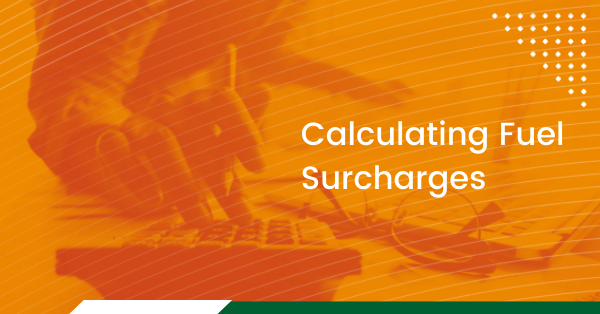This past month fuel prices have been a significant discussion among all U.S. citizens. Unfortunately, many industries have felt pressure on their bottom line due to these increased prices, and the freight industry is no exception.
Knowing how to calculate a fuel surcharge will help you immensely – whether you book your loads and set your rates or lease with a company that does it all for you. This way, you will know whether your company’s surcharge will offset your increased fuel costs.
A Fuel Surcharge is part of the final bill to compensate your carrier. But what exactly is it, and how is it calculated?
What are fuel surcharges?
A fuel surcharge is the total cost of gasoline or diesel fuel used to move one shipment. Since fueling up is often the most expensive part of a long-distance shipment, companies charge their customers a surcharge rate that appears on their invoices. This added charge serves as compensation for all gasoline purchased during the transportation of their load. It helps to reduce some of the financial burden placed on the carrier.
How do companies calculate fuel surcharges?
Fuel surcharges will be added to the total freight charges on either a per-mile or percentage basis and based on an average mile per gallon and the national average of diesel prices on the U.S. Energy Information Administration (EIA). The EIA does not dictate how to calculate a fuel surcharge. Instead, the shipper and trucking company negotiate it privately. Therefore, each company has its method for calculating surcharges.
The shipping company updates a fuel surcharge rate to ensure that the customer pays the most accurate price per gallon. These rates differ from company to company. Typically, they are calculated as a fixed percentage related to a one-cent increase in the cost of a gallon of fuel.
For example, the price per gallon rises from $3.00 to $3.03. The total increase in price would be 30 percent (.1 X 3). Likewise, if the fuel price falls from $3.00 to $2.97, the fuel surcharge rate would decrease by 30 percent. (A ten percent increase on the penny is an astronomically high amount, with the average rate usually less than a half percent increase, but in easy math, we’ll leave it at an even 10).
What numbers are needed to calculate fuel surcharges?
To calculate your business’ fuel surcharge, you need to know a few numbers specific to your business. They may include the actual cost per mile and your truck’s fuel mileage.
The actual cost per mile
The most important factor you can know for your business is your actual cost per mile. This cost should include everything you spend on running your business: truck payments, insurance, health insurance, fuel, maintenance, etc. You also want hidden costs like future repairs, equipment replacement, and maintenance. It is essential to know your business costs so that the broker doesn’t lose money when you set a rate or pick a load to haul from a broker. Otherwise, you ultimately pay to transport the load, which is the opposite of what you want to do with fuel surcharges.
When you calculate your costs per mile, you will see that fuel is the highest cost to your business and is constantly changing. Fuel price volatility makes it difficult to negotiate long-term contracts, but long-term contacts are essential. A surcharge allows those contracts to accommodate short-term price fluctuations. To deal with these rapid changes when setting rates on a load, trucking companies have settled on adding a fuel surcharge.
Calculating formula
The most used formula uses three things that the involved parties agree upon:
1. Base fuel price
2. Base fuel mileage
3. Source and interval of the current fuel price
When a surcharge uses these factors, it clarifies the billing and protects all parties involved. For example, the base fuel cost was $2.00 and the current fuel cost is $3.00. In this case, you need to charge an extra $1 for each gallon of fuel you buy while hauling the load. Since your load rates are per mile, you need to calculate the fuel surcharge per mile, too. This is where knowing your fuel mileage comes in.
Once you know the fuel mileage, then the fuel surcharge is simply $1.00 per gallon divided by your truck’s miles per gallon. If your truck gets five mpg, then the fuel surcharge would be $1.00 / 5 mpg = $0.20 per gallon or 20 cents per gallon.
What if you lease with a company?
If you lease with a company, the calculation is even more straightforward, as long as you know your actual costs per mile.
All that is required is to compare the load rate and fuel surcharge to your actual costs per mile. Then, if the total rate and fuel surcharge are high enough above your expenses to make it worth your while, you are good to go!
Once you understand how surcharges work, you realize the profit potential. Because fuel surcharge calculations involve some sort of fuel mileage average, a fuel-efficient owner-operator or small fleet owner can consistently beat the standards.
Partnering with a 3PL
The best way to ensure that you know how much your fuel surcharges will be is by partnering with an experienced third-party logistics (3PL) provider who can assist you with that process. By partnering with PLS Logistics Services, we give businesses propriety access to our Transportation Management System (TMS), PLS Pro.
Contact us to learn more about our TMS and how we can help you!


